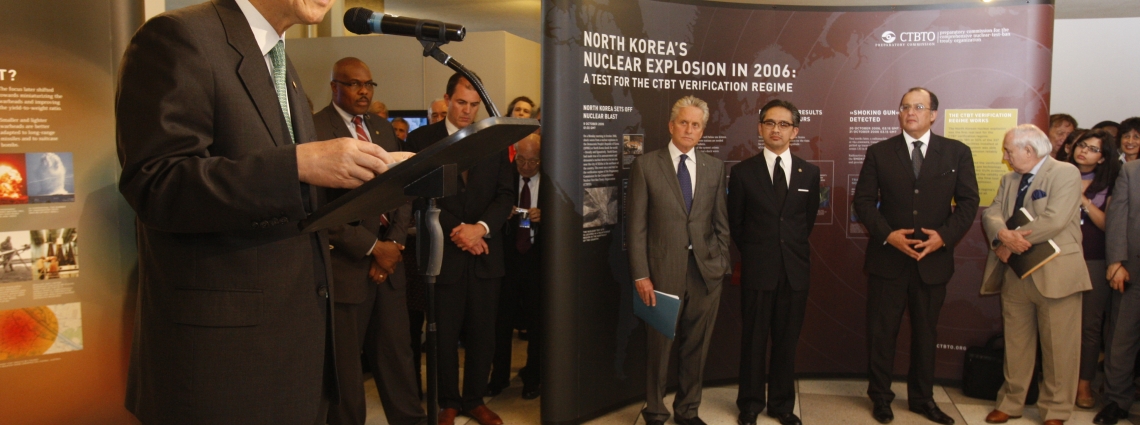“Do the right thing: ratify the CTBT!”
Over 300 guests attended exhibition opening
The opening took place on the second day of the 2010 Review Conference of the Nuclear Non-Proliferation Treaty (NPT). Over 300 guests were in attendence including foreign ministers, ambassadors, high-level delegates to the conference, representatives of disarmament NGOs and the civil society as well as the international media. Present also was Taïb Fassi Fihri, the Minister of Foreign Affairs of Morocco. Morocco and France are the coordinators of the entry-into-force process under Article XIV of the CTBT.
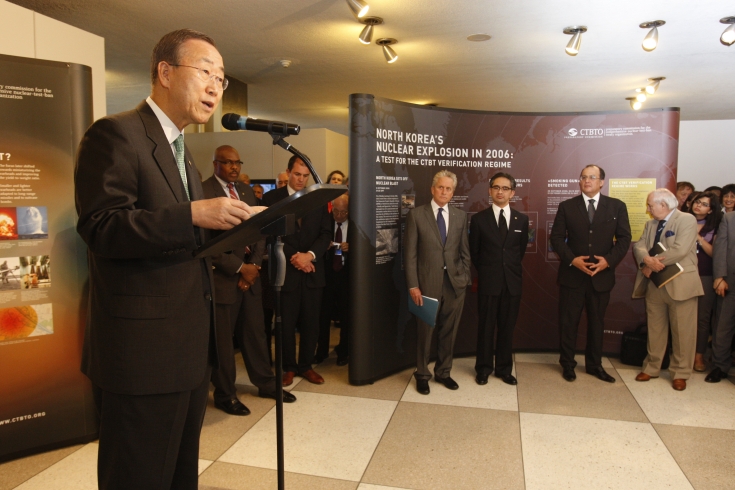
UN SG Ban Ki-moon: “Putting an end to nuclear explosions – is one of the longest-standing goals of the United Nations.” Photo: UN Photo/Eskinder Debebe
Actor/producer and UN Messenger of Peace Michael Douglas was among those addressing the gathering ( statement ). He referred to his birth year, 1944, as the year before nuclear weapons were used for the first and last time when he said: “I certainly hope to see these terrible means of destruction eliminated in my lifetime.” He added that the nightmarish quality of nuclear weapons had haunted him since his childhood and stated: “I see no reason why our children should bear the same burden of living in the shadow of these terrible weapons. The necessary steps can be taken now.”
Reaffirming Indonesia’s commitment
Those necessary steps can indeed be taken now, as was illustrated by Marty Natalegawa, Indonesia’s Minister of Foreign Affairs ( statement ). He reaffirmed Indonesia’s commitment to initiating the process of ratification of the CTBT: “Today, from the vantage point of the year 2010, and in view of the present glimmer of hope in the nuclear disarmament agenda, the Government of Indonesia believes that it can now enhance its contribution by initiating its own ratification process.”
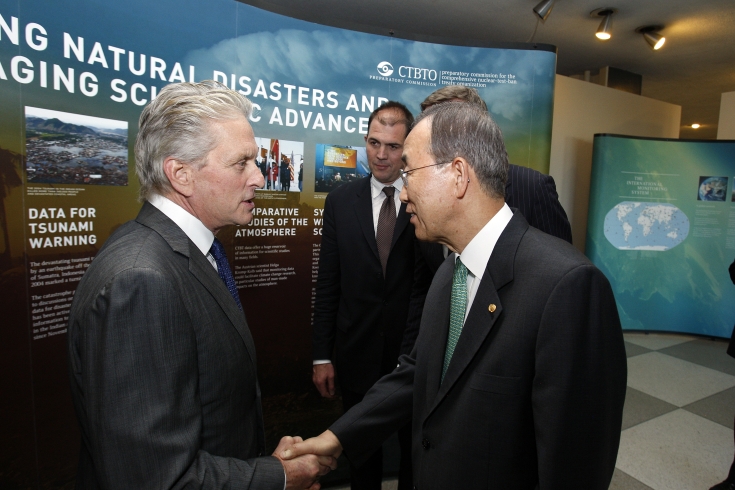
UN Messenger of Peace Michael Douglas (left) and UN SG Ban Ki-moon. Photo: UN Photo/Eskinder Debebe
The Treaty “is a strong non-proliferation instrument, a catalyst for nuclear disarmament,” said Tibor Tóth, Executive Secretary of the Preparatory Commission for the Comprehensive Nuclear-Test-Ban Treaty Organization (CTBTO) ( statement ). He called for determined political leadership so that the norm against nuclear testing can “be properly inscribed in the international rulebook.”
Moving forward
Looking to the future, Tóth informed the assembled guests that the CTBT is moving forward: “We will establish a network of partnerships designed to strengthen and broaden the participation in the CTBTO global monitoring and verification efforts.”
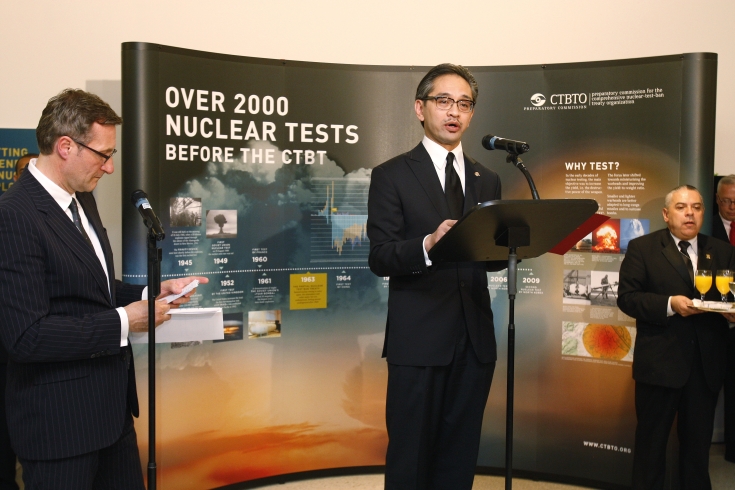
Marty Natalegawa, Indonesia’s Foreign Minister: “Do the right thing: ratify the CTBT!” Photo: UN Photo/Eskinder Debebe
The exhibition illustrates the complex history of nuclear testing – from the first nuclear test conducted by the United States in 1945 to the last one in the Democratic People’s Republic of Korea in 2009. It also depicts the efforts towards prohibiting nuclear testing, culminating in the adoption of the CTBT in 1996.
Several displays provide a realistic impression of the Treaty’s globe-spanning alarm system that monitors the planet for signs of nuclear explosions. They also show how the one-billion dollar CTBT verification system proved its worth by detecting the two nuclear explosions conducted by North Korea in 2006 and 2009 both timely and reliably. Finally, the exhibition provides insights into how the technological investments could be put to good use in the realms of disaster mitigation and scientific research.
The exhibition will be on display for two months, until the end of June, and is open to the public.
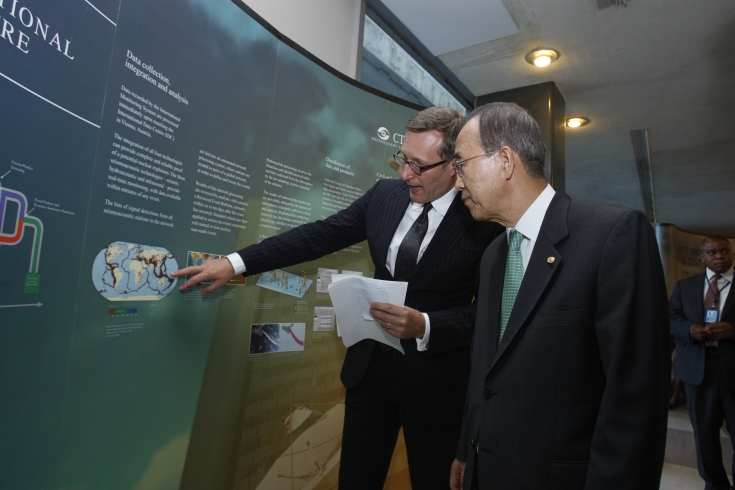
UN SG Ban Ki-moon (right) and CTBTO Executive Secretary Tibor Tóth in front of an exhibit. Photo: UN Photo/Eskinder Debebe
The CTBT is close to universality. 182 States have signed the Treaty, 151 have ratified it. Yet nine ratifications are still outstanding for the Treaty to enter into force. Against this backdrop, Indonesia’s Foreign Minister Natalegawa repeated the call that was made by many speakers at the NPT Review Conference: “Do the right thing: ratify the CTBT!”
6 May 2010
